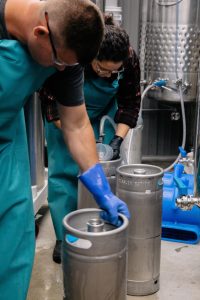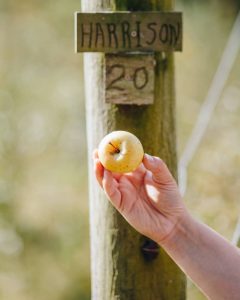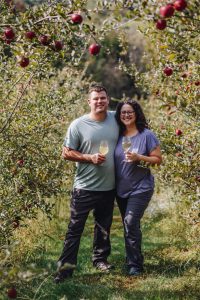Hard Cider 101
Photos by Gab BonghiAnother way to enjoy apples
Hard cider is thoroughly misunderstood in America. Is it brewed like beer? Distilled like vodka? What makes cider hard cider? And why should I try it?
Hopefully, by the end of this crush course (pun intended), you’ll know more about this tasty beverage and may be curious enough to try some yourself. And then fall in love with it.
Why Hard Cider?
 Hard cider — the alcoholic version of apple cider — is a versatile drink, pairing well with many foods, from hearty roasts to nuanced desserts. It also stands well on its own, showing deep, rich, earthy and complex notes, or other varieties tending toward floral notes and fruit aromas.
Hard cider — the alcoholic version of apple cider — is a versatile drink, pairing well with many foods, from hearty roasts to nuanced desserts. It also stands well on its own, showing deep, rich, earthy and complex notes, or other varieties tending toward floral notes and fruit aromas.
A perfect thirst quencher on a scorching summer day, hard cider can just as easily be warmed with spices to thaw the frostiest bones in winter. This multipurpose drink can serve as the backbone for a staggering variety of cocktails (using hard or nonalcoholic cider), as well as stand in for beer and wine for cooking — for braising a roast, making buttery pasta sauces or creating a sweet reduction to glaze a dessert. Frankly, there’s not much cider can’t do.
Some History
The recent resurgence of cidermaking in the U.S. started in the early 2000s, but the tradition dates back to early settlers in America — and even further back in the United Kingdom and Ireland, where hard cider is popular to this day.
Sadly for American cider lovers, the drink faced a setback during Prohibition when overzealous activists from the Temperance movement cut down many cider apple trees. After Prohibition ended, the slow growth of apple trees compared to much quicker barley harvests gave beer a massive head start in production. Plus, the nation’s shifting demographics, led by a surge of German immigrants, increased demand for beer.
And so hard cider never completely bounced back after Prohibition. Although the drink was appreciated by a small group of devoted fans and kept alive by a handful of artisans, hard cider remained a niche product.
In the early 2000s, only a few hard ciders were available in the U.S., mainly Woodchuck Hard Cider from Vermont and Strongbow Apple Ciders imported from the United Kingdom. Then Angry Orchard began production of a mass-market cider at a low price point. Angry Orchard’s large advertising budget pushed the product nationwide, resulting in the cider category experiencing astronomical growth seemingly overnight and proving hard cider was a viable product in the U.S.
Eventually, lovers of hard cider began yearning for a drier (less sweet) product, one with more nuance and dimension, as Angry Orchard leaned heavily into sweet, flavored ciders. Purists sought out the core taste of cider (another pun), much like craft beer fans in the 1990s searched for authentic beer tastes and varieties.
Cidermaking Basics

Basically, hard cider is produced by using yeast to ferment apple juice into an alcoholic product. Think of hard cider as apple wine: to create the main ingredient, apple juice, apples must be grown on trees, then harvested and ground into tiny pieces before being pressed to extract the juice.
Cidermakers, from international conglomerates to home enthusiasts, approach this work in different ways — some purchase apples or juice from outside sources, while others do it all themselves, soup to nuts. Other decisions also affect the final product. Choices of apple varieties and ratios in the blend impact the sugar, acid, tannin and aromatics of the cider. Yeast selection also affects the final sugar levels and flavor, as cidermakers use wine or beer yeasts or opt for wild fermentation with native yeasts from the apples’ skin.
After fermentation, hard cider is rested to clarify naturally — filtering out yeast and other solids — in stainless steel tanks or oak barrels, which can impart additional flavor. Then the cider can be carbonated in a pressure vessel using added carbon dioxide, carbonated in the bottle (similarly to Champagne) or, like many wines, bottled still, with no carbonation.
A cidermaker’s choices are endless and incredibly fun to explore.
Hard Cider Varieties
Many hard cider fans outgrew the overly sweet options from mass-market producers, instead craving drier ciders. As a result, modern hard ciders now use more apple varieties we’re familiar with for eating and cooking, like Granny Smith, Honeycrisp and Gala. These apples have high sugar and acid but low tannins — natural compounds that add complexity on the palate and a drying sensation in the mouth. The result is a bright, tart cider with gentle apple notes.

Heritage ciders, on the other hand, use antique or heirloom apple varieties. These apples aren’t as commonly grown nor are they as tasty to eat — some are incredibly tart, bitter and unbalanced tasting.
Some heritage apples, such as Golden Russet, have rough skin like a potato and are just as hard to bite into but have a deep, honeyed flavor. Another, Hewe’s Crab, has orange golden skin and a bright, sweet flavor, but is as small as a golf ball and can be mushy when eaten. And the Wickson variety has very high acid but equally high sugar, tasting like lemonade.
Heritage ciders made from these apples are unique and provide a larger canvas for tasting the growing conditions of the orchard, allowing chalky and mineral notes from the soil to linger in the background, like the terroir of fine wines.
Other popular cider varieties include rosé ciders, made from apples with pink or red flesh or by adding fruit like strawberries or red wine grape skins. And ice ciders make use of freezing winter temperatures’ impact on apples to yield more concentrated juice, producing a sweeter and more alcoholic cider with incredibly strong apple notes.
Yet another factor affecting ciders’ taste is wood aging. Like wine, hard cider can be wood-aged, in barrels or on chips, producing a range to tastes from fruity to chocolatey to smoky, depending on the wood type, growing region and char level. And like beer, cider can also be hopped, using a myriad of hop choices and flavor profiles.
We could talk about many more cider styles, but then there’d be no room for other articles in this issue of County Lines!
Local Connections

A final important factor in your cider education is that good cider starts in the orchard. At Dressler Estate, our process leans heavily on local agriculture, sourcing all our apples within Pennsylvania, with most coming from orchards in Chester County or nearby counties. All our apples are fresh, sourced directly from trusted growers. (When we use juice, we pick it up ourselves the day it’s pressed.)
A quarter of our apples come from Valley Creek Orchard, a one-acre, high-density cider apple orchard just south of Downingtown. We manage this private site, which sits on a hilltop overlooking Valley Creek and produces exceptional cider apples, alongside landowners Mary Lee and Bruce Colley.
When it comes to hard cider, we think of ourselves more as caretakers than makers. The apple trees and the land do the hard work of growing the apples, then the yeast does the work of converting sugars in the apple juice into alcohol and carbon dioxide.
What we do is ensure conditions are optimal for those components to work best through rigorous cleaning, sanitation, temperature control and monitoring, intervening only when necessary and then minimally. This approach creates ciders that are expressive of the land and climate, with distinctive terroir, allowing special qualities in our ciders that make them unique.
Thank you for taking a short, but hopefully informative dive into the world of ciders.
Dressler Estate’s husband-and-wife-owned cidery believes in the power of small businesses working with the community. Visit them at local farmers markets (Downingtown, Phoenixville, Chestnut Hill and more) and look for a retail taproom on Lancaster Ave. in Downingtown, planned for late spring 2024. Follow on social media @DresslerEstate or sign up for the newsletter on their website, DresslerEstate.com. Remember to shop local and support small businesses in your community!
